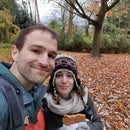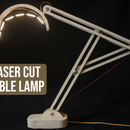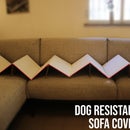Introduction: Simple Laser Diffraction Experiment at Home
Long story short: You will learn how to observe interference patterns at home (using the cheapest laser point you got). I will also teach you how to use your laser to measure tiny objects, like the width of your hair!! It's super easy!
* This instructable can seem a bit technical, so feel free to ask me stuff!
If you find physics interesting I suggest you read through (at least the introduction part!) before you skip to the pictures and videos and how-to's!
Long story starts here:
So interference patterns look cool, but so are many other things!! why should we study them??
As a physicist you get to study how things work. You start with the basics - mechanics (Newton and his buddies from the 18th century), and gradually move towards the 19th century where you learn about electro-magnetism (Maxwell and such) and eventually you get to Quantum Mechanics and Einsteins relativity. There are many universalities to these theories, but my favorite is that they can all describe waves.
Whether it's the waves on the surface of a pond or a vibrating string which are usually described by Newtons laws, light, which is an electromagnetic wave, gravity waves described by Einsteins theory, or miniature particles described by wave mechanics (aka Quantum Mechanics) - they all share many similar properties.
This makes the study of waves an extremely important part of the education of physicists. In my opinion, it helps you develop intuition and see the world differently. Once you study what waves are, you begin to see them everywhere.. and it's beautiful! One of my favorite wave phenomena are related to wave interference, which lead to interference patterns.
Supplies
To perform the single-slit experiment at home, you'll need:
1) 2 old credit-cards (or some more plastic cards). I painted mine with a dark permanent marker
2) A piece of plywood (about 1/2 inch thick).
3) 2 short flat-end screws (about 1/2 inch long).
4) 2 longer flat-end screws (about 2 inches long) and suitable nuts.
5) Rubber bands
6) 6 small right-angle joints (see picture)
7) a laser pointer
Step 1: What Are Interference Patterns?
We all know what waves are from our everyday lives, but what are they, really?
Waves are disturbances to a "field". In the case of sound waves, for example, this "field" is the air-pressure around us - sound waves are simply disturbances to the air pressure that travel through space. For our purposes, we should consider a simple case where these waves are periodic in time.
I added a video from Veritasium's channel that talks about waves. It's a nice video that should teach you the basics of waves.
Now, imagine two identical waves travelling through space. When these two wave collide with, they add up to form a single disturbance. Many waves are even simpler than that - the magnitude of the combined oscillation is simply the sum of both waves.
There are two interesting cases to talk about. If both waves happen to meet at a point in space while both oscillations are at their maximum, the wave we would see when we look at it would be a single wave, with twice the magnitude of each one separately. This is called constructive interference. Alternatively, if the two waves meet at a point in space while one is pointing 'upwards', while the other is pointing 'downwards' (one is positive and the other is negative), they completely cancel each other out! This is called destructive interference.
An interference pattern is what you get when you look at more than one point in space. For example, if you throw two rocks into a pond, their ripples would interfere with each other in many places - in some points they would interfere constructively and in others they would interfere destructively.
Step 2: The Single Slit Experiment
Light, as it turns out, is also a wave (it is a disturbance in the electromagnetic field). This means that light beams can also interfere with each other! There are many ways to see this, but one of the simplest experiments is the single-slit experiment.
When a light-beam (a wave) hits a narrow slit, it shatters in many directions. Each point of the slit would behave a source for new waves, which could interfere with each other. If we now place a piece of paper a few feet away from it, we would see the resulting interference pattern!
This pattern can be predicted from the physics theory of waves. In our case, it is only interesting to quote the final results, which is called a "sinc" function (see the image I attached). The cool part is that this pattern can tell us stuff! For example, if we know the width of the slit, and the distance from the slit to our piece of paper, we can calculate the wavelength (~the period) of the light-wave we used! If, on the other hand, we know the type of laser we used, we can measure the width of tiny objects using the simplest laser-point we got!
But more about this later, for now, let's first see how to observe this pattern using a cheap laser-pointer.
Step 3: Assemble the Experiment
First, attach two short flat-head screws and a right-angle joint to one of the plastic cards (see first picture). On the other side, attach another right-angle joint (see 2nd and 3rd picture). Notice their orientation. Similarly, attach right-angle joints to the other plastic card so that they face each other (see 4th image).
Next, fix one of the plastic cards to the plywood. Now use two more right-angle joints such that they form a track pointing at the previous (fixed) card. This will allow the 2nd card to slide towards the first (fixed) one. Attach these joints to the plywood (see picture 4).
You should now have one fixed plastic card and another that can slide towards it.
Finally, screw in a long screw to the plywood next to the sliding card (pointing upwards), and connect it with rubber bands (see pictures 4-5). Connect the two cards using long flat-head screws. When you screw the them in, the cards should come closer to each other, and when you unscrew them, the cards should move apart.
I also added a small stand for the laser-pointer with rubber bands holding it to place (see last image). When I turn the laser on, the beam hits the slit formed between the two cards (see last picture). When I move the cards close to each other, a diffraction patter is formed!
Step 4: Single-Slit Experiment
Safety First
Laser pointers, of any kind, can damage your sight! do not point them at anyone's eyes or at any reflective surfaces. The cheapest lasers often have a much higher potential for damaging your eyes!
Performing the Experiment
Place your laser + slit at a given distance away from a white wall. About 2-4 feet away should be fine.
Turn on the laser and displace the move-able card such that the laser beam passes through without hitting the plastic cards.
Now, using a screwdriver, slowly bring the two plastic cards closer together such that a narrow slit is formed between them. Notice what happens on the wall! As you bring the cards closer to each other, the interference pattern on the wall becomes larger and larger!!
In the video you can see what it should look like when you change the width of the slit back in forth. I also took a picture with my phone and analysed the light intensity (gray-scale) using a free software called imageJ. Notice how it very much resembles the 'sinc' function I mentioned earlier!
Step 5: Using Laser to Measure Tiny (microscopic) Objects
How can we use this interference patter to measure microscopic objects?
When sizes are larger than, say, a millimetre, you can use ordinary tools such as a ruler or a caliber to measure them. But when you reach the micrometer scale, things get more complicated (at least at home!). For example, a human hair is about 100 micro-meter thick, and it's not that easy to measure it using everyday tools!
We can overcome this using a cheap laser pointer! It turns out that if you know the wavelength of the laser you're using (red lasers are usually ~630-670 nano-meters, 650nm would be a good approximation) and the distance between your object (in our case, the slit) to the wall, you can calculate the size of that object!
All we need to do is measure the distance between the central lobe (the bright spot in the middle) to the next bright spot. Let's denote this distance by the letter 'y'.
The image is taken from hyperphysics. Let's use their notation. If we denote the size of the object we're measuring by the letter 'a', the distance from that object to the wall by 'D' and the wavelength by the Greek letter 'lambda'. Using these notations, the size of the object is given by:
a = 3/2 * lambda * D / y
In the image they have decided to measure the distance from the first lobe to the following dark spots - you can can even use their calculator to plug in the measurements you took in order to calculate the size of the object you've measured.
But this is just a slit, how can we use this to measure other objects?
It turns out that if you take other objects which are narrow enough, such as a human hair, the resulting diffraction pattern will be very similar (and often identical) to the single-slit experiment! This means that the same formula I showed you earlier works just as well!
So.. if you want to measure tiny objects, just shine a laser beam at them, and analyse their diffraction pattern!
If you want to see this happens, just take a single human hair and hold it against your laser pointer. This will create a diffraction pattern which you can use to measure the width of your hair! I used this and found that my hair is about 100 micrometers thick!
That's all for today! see you soon :)




